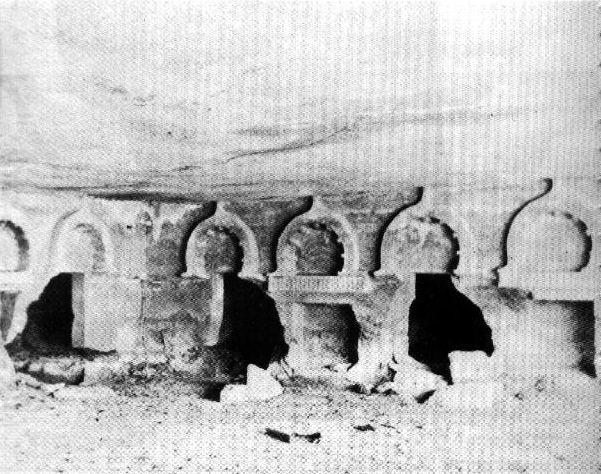

"There is an ancient legend among the Hindus of India that tells of a civilisation of immense beauty beneath central Asia. Several underground cities are said to be located north of the Himalayan mountains, possibly in Afghanistan, or under the Hindu Kush. This subterranean Shangri-la is inhabited by a race of golden people who seldom communicate with the surface world. From time to time, they travel into our land through tunnels that stretch in many directions. Entrances to the tunnels are believed to be hidden in several of the ancient cities of the Orient. Tunnel entrances are said to be in Ellora and the Ajanta caverns in the Chandore Mountain range of India." Eric Norman
Below: Photo of "Glowing Mountain" Following Underground Nuclear Tests in Pakistan, 28 May 1998
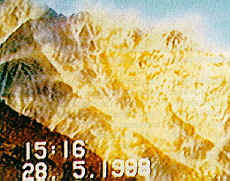
The above photograph is a clip from German television. It shows a mountain on the India-Pakistan border which is anomalously glowing following a series of nearby underground nuclear bomb tests. Source of image: Dr. Franz Lutz of IRT in Germany.
Here is another one, before and after:
The photo raises questions for the hollow earth community, implications for particle physics notwithstanding ( light isn't supposed to pass through mountainsides ). We have to wonder if bunker buster bombs, which drill their way underground before they detonate, don't have the purpose of collapsing cavern worlds, or at least of collapsing the tunnels which provide access back and forth. And why? Could it be that the subterranean manipulation of the surface world is true, orchestrating much of the reality which we mistake for spontaneous development?
"Defence analysts say the US armed forces have been increasingly interested in developing a range of weapons to hit deeply buried targets."
And here is one of them: Penetrator!
From the Brinsley Le Poer Trench book, page 61:
“Among the Mongolian tribes of inner Mongolia, even today, there are traditions about tunnels and subterranean worlds which sound as fantastic as anything in modern novels. One legend, if it be that, says that the tunnels lead to a subterranean world of antidiluvian descent somewhere in a recess of Afghanisthan, or in the region of the Hindu Kush …”
“It is even given the name Agharti. The legend adds that a labyrinth of tunnels and underground passages is extended in a series of links connecting Agharti with all other such underground worlds! … The subterranean world, it is said, is lit by a strange green luminescence which favors the growth of crops and conduces to length of days and health.”
“This last account is of special interest because Kolsimo refers to this green fluorescence in another part of the world. He writes in Timeless Earth about a strange “bottomless pit“ in Azerbaijan in the Soviet Union. Apparently, a bluish light comes from its wall and odd noises are heard. Eventually, after investigating and exploring, scientists found a whole system of tunnels connecting with other ones in Georgia and all over the Caucasus.”
End of Brinsley Le Poer Trench Quote
Pages
of Interest:
Balls of Light Amazon Female Warriors
The Contradictory Architecture of Egypt

U.S. VETERAN REVEALS ATOMIC BOMBS DROPPED
ON AFGHANISTAN AND IRAQ
PART III
NUKING TORA BORA
willthomasonline.net exclusive
On Tuesday evening, November 12, 2001, Babrak Khan, a Jalalabad resident and former guard at a
nearby base for Islamic militants, saw the distinctly bearded and emaciated Osama bin Laden
standing in front of a guesthouse. The next day, Osama and his al-Qaeda and Taliban followers
headed into the nearby Tora Bora mastiffs.
American bombing of the region intensified. The 11th day of Ramadan - November 26, 2001 - saw
Osama seated deep inside a cave complex with a glass of hot green tea in hand. Mohammed Akram,
who occasionally cooked for bin Laden, was fixing dinner in another cave when a huge bomb
exploded, blowing him 30-feet backwards. Two of his colleagues were killed, and Mohammed, along
with another Saudi and a Kurdish fighter, decided not to hang around.

Osama bin Laden fled Tora Bora around December 1, heading for Pakistan's Parachinar region.
Eastern Afghanistan's intelligence chief, Pir Baksh Bardiwal was astounded when the Pentagon
failed to use convenient helicopter Landing Zones to insert U.S. forces to block the most obvious exit
routes.
But the Americans did not know the ailing terror financier had left Tora Bora. When Osama bin Laden
phoned back to the enclave on December 10, urging his followers to keep fighting, U.S. intelligence
officers picked up his transmission and conclued that Osama bin Laden was still in his caves.
[Christian Science Monitor Mar 4/02]
Which might also explain why a USAF C-130 had dropped the heaviest bomb in their conventional
inventory - a 15,000 pound “Daisy-Cutter” - against Tora Bora the previous day. [London Times Dec
10/01]
THERMOBARBARIANS
Rushed into production after 9/11, at least eight BLU-118Bs were quickly deployed into the Afghan
theater. The Global Security website confirms the first field-test of this new weapon: “On or about
March 3, 2002 a single 2,000-pound thermobaric bomb was used for the first time in combat against
cave complexes in which al-Qaeda and Taliban fighters had taken refuge in the Gardez region of
Afghanistan.” [globalsecurity.org]
Guided by U.S. Special Forces “lasing” cave complexes with invisible laser pointers, the Navy's new
polymer-bonded “thermobaric” bomb would be more accurately termed a “thermobarbaric” terror
weapon.
"It works as a combination of a shock wave and a fuel explosion," explained CENTCOM Commander
Matthew Klee. "The first explosion spreads flammable aerosols through the underground complex.
Then, the second ignites the fuel” - crushing the internal organs of everyone caught in the blast zone.
“Instead of boom, this bomb goes BOOOOOOOM!” thundered Air Force spokesman Captain Joe
Della Vedova. “This thing kills the earthworms.” [Las Vegas Review Jan 21/02]
Over the March 1, 2002 weekend, the Pentagon tested two more “experimental” BLU-118B MOABs
during Operation Anaconda. Was this “Mother Of All Bombs” also the Mother Of All Deceptions?
“This sort of cover-story makes it easy for, say, reporters, to believe they have witnessed a fuel-air
explosion, when in fact it was a very small, low-yield, nuclear weapon,” George Paxinos pointed out
at the Information Clearing House. Why else would “the USA suddenly publicly announce in 2001
and 2002 its intention to use this sort of weapon against the Taliban hiding out in caves, when in war,
you do not usually go out and broadcast your intentions… to your enemy?”
And why, Paxinos pondered, would this “intense propaganda effort” to alert Americans and the world
to Washington's new Massive Ordnance Air Burst Weapon emphasize that the resulting blast
“produces a fireball and a mushroom-cloud almost indistinguishable from that of a small tactical
nuclear weapon?”
And why did CNN, among other networks, parrot Washington's nonsensical assertions that an airburst
bomb originally designed “to be used against large formations of troops and equipment” would
now be deployed against “deeply buried targets"? The network helpfully hinted, “Officials suggest
perhaps the Iraqis might even mistake a MOAB blast for a nuclear detonation." [CNN Mar 11/03]
“This is a cover-story,” Paxinos asserted. We were “being prepared for the pre-emptive use of tactical
nuclear weapons.”
DU expert Tedd Weyman points to George Bush's revised Nuclear Posture Review. Issued in March
2002, the new NPR pledged to test Nuclear Penetrator Missiles. “That's my hunch,” Weyman
believes. “We tested the prototypes there.”
Paxinos and Weyman were right.
According to Hank, under the cover of massive DU-tipped bombs that raised dirty mushroom clouds
in thunderous explosions that rained radioactive dust over Jalalabad and nearby villages, the first
nuclear bombs dropped since Basra in 1991 were detonated by American forces in Afghanistan
beginning in March 2002. Before their field tests were concluded, United States forces would explode
four 5-kiloton GBU-400 nuclear bombs in Tora Bora and other mountainous regions of Afghanistan.
In order to obtain a seismographic “snapshot” of a mountain's internal structure, at least one of these
four nuclear detonations took place alongside a craggy karst in the open air.
Hank's buddies, who were on the scene, told him what happened far from scrutinizing media eyes in
the remote mountains of northern Afghanistan. As he paraphrased their reports: “Back our guys
away from the general area - 'Don't look that way for two or three seconds' - and oops! we blew that
up.”
With shockwaves rippling through the mountains, and fallout spreading through mountain passes,
Taliban and al-Qaeda fighters knew that something momentous had occurred. But killing a few of the
enemy in collapsing rock and a nuclear fireball actually proved counterproductive, Hank related. “It
drove others deeper into less accessible areas. It backfired.”
JUMPING NEEDLES
Wouldn't seismographic needles jump on distant dials, I asked Hank?
They did, he replied. But pinning down the source of such blasts in nearly impossible.
“You may hear something, but you would not be able to designate it because there was too much
else going on. There's no way you could call it,” Hank explained. A major conventional explosion,
such as a huge C-130 or C5 Galaxy transport plane auguring in, “would give you the same
seismographical signature.”
Keith Nakanishi and other seismologists at the Lawrence Livermore nuclear bomb labs agree that
detecting, locating, and identifying a clandestine nuclear explosion is particularly challenging in the
Middle East, where unusual tremors picked up by a few, widely scattered seismic monitoring stations
would be drowned out by a large number of earthquakes and mining and oil drilling explosions. Add
to this cacophony, waves of cruise missile strikes and massive bombs dropped by American
warplanes.
Nevertheless, the Livermore seismologists state that among “thousands of seismic signals annually,
some [are] quite similar to the signals that would be generated by a small underground nuclear
blast.”
If major megaton-size nuclear weapons tests cause earthquakes, could a “baby nuke” do the same.
The U.S. Geological Survey admits that even “deep mining can cause small to moderate quakes,
and nuclear testing has caused small earthquakes in the immediate area surrounding the test
site.” [earthquake.usgs.gov]
The Livermore scientists also note that a conventional 1,000 pound explosion set off by Israel on the
shores of the Dead Sea on November 8, 1999 resulted in a quake of magnitude of 2.6 on the Richter
scale. A 2,000-kilogram explosive detonated two days later, caused a 3.5 quake. [llnl.gov]
Each of the four nuclear weapons dropped on Afghanistan set off a bedrock-amplified explosive force
of 10,000 tons.
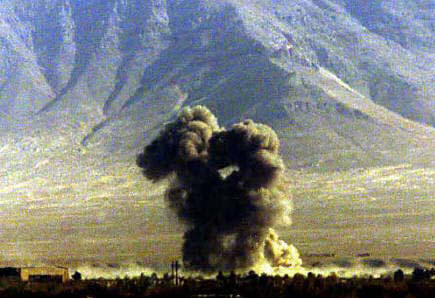
QUAKES
The blasts in Tora Bora were immediately followed by a severe earthquake that “struck northern
Afghanistan and was felt as far away as India,” the People's Weekly World reported. Even in this
earthquake-prone region, the long-lasting and powerful tremors were unprecedented, killing 150
people killed and destroying 500 houses.
“It is not unlikely that the use of powerful bombs led to the quake,” one geophysicist said.
Moscow thought so, too. An ITAR-TASS report speculated that the 7.2 Richter-scale 'quake that
struck northern Afghanistan “may have been caused by the powerful fuel-air and bunker-penetrating
bombs used in earlier U.S. air strikes in that same region.” [whatmatters.nu]
Reviewing the stresses “induced in the earth's crust” by powerful explosions, Kamran Ahmed
reported from Karachi, “The severe earthquakes that struck Afghanistan in March can be attributed to
these bombings.”
But were the quake-triggering blasts nuclear?
Gary Whiteford, Professor of Geography at the University of New Brunswick in Canada is renowned
for his exhaustive research correlating nuclear tests and earthquakes. Looking at “killer earthquakes”
that kill at least 1,000 people, Dr. Whiteford found that 63% of those earthquakes occurred within one
to three days after a nuclear blast test. [dawn.com]
In 50 years before atomic testing began, 68 earthquakes of more than Richter 5.8 occurred every
year. When hundreds of atomic bombs started going off in what can only be described as a largescale
nuclear war against the Earth, the quake rate rose "suddenly and dramatically" - nearly
doubling to an average 127 major quakes per year.
TheU.S. military attributes the telltale increase to "coincidence." But Whiteford comments, "The
geographical patterns in the data, with a clustering of earthquakes in specific regions matched to
specific test dates and sites do not support the easy and comforting explanation of `pure
coincidence.' It is a dangerous coincidence."
“Abnormal meteorological phenomena, earthquakes and fluctuations of the earth's axis are related in
a direct cause-and-effect to testing of nuclear devices,” concurs Shigeyoshi Matsumae, President of
Tokai University, and Yoshio Kato, Head of the University's Department of Aerospace Science.
As Matsumae and Kato point out: “On June 19, 1992, the United States conducted an underground
nuclear bomb test in Nevada. Another test was conducted only four days afterwards. Three days
later, a series of heavy earthquakes as high as 7.6 on the Richter scale rocked the Mojave desert
176 miles to the south. They were the biggest earthquakes to hit California this century. Only 22
hours later, an "unrelated" earthquake of 5.6 struck less than 20 miles from the Nevada test site
itself. It was the biggest earthquake ever recorded near the test site and caused one-million dollars of
damage to buildings in an area designated for permanent disposal of highly radioactive nuclear
wastes only fifteen miles from the epicenter of the earthquake.” [ratical.org]
So far, more than one million people have died in earthquakes that could be related to nuclear tests.
[ratical.org]
WATCH THE BIRDIES
Meanwhile, Taliban fighters pounded night and day north of Kabul were dying from no visible injuries
- except the blood flowing out of their mouths from internal bleeding. Near the Rish-Khor military
base in the Afghan northern capitol, birds sat on tree branches with blood running from their beaks.
As one eyewitness later recounted, "'We were amazed to see all these birds sitting quietly on
branches. But when we shook the tree the birds fell down and we saw blood coming out of their
mouths. Then we climbed the trees to see those that were still stuck on tree branches, all of them
had bled from their mouths. Two of the birds appeared to be partly melted into the trees branches'."
According to PhD Mohammed Daud Miraki, who collected many first-hand accounts on the aftereffects
of heavy U.S. bombing, “many dead Taliban soldiers had severe discoloration of the skin,
orange, without being burned, while others had their rifles melted in their hands.”
A medical doctor named Wazir reported, "Most of the victims have had respiratory problems and
internal bleeding for which there is no apparent cause." [khalifa.com Oct 30/01]
Were these symptoms caused by the massive concussive blasts of fuel-air bombs?
Very likely. When American jets dropped bunker busters at daybreak on the mud homes of Karam,
the village was completely destroyed in massive craters. Many residents were killed from what
appeared to be internal concussive injuries.
But other victims of American bombing exhibited symptoms of radiation sickness. In describing
“another bizarre, yet tragic scene,” Dr, Mohammed continued, “Many Taliban soldiers that survived
the bombing in the north have died after returning to their native villages in the south and southeast
of the country. They had no physical injury upon their death, however, died from internal bleeding
and other bizarre symptoms including uncontrolled vomiting, diarrhea, and blood loss in urine and
stool. Their families were shocked with disbelieves.” [Afghan DU & Recovery Fund]
Perplexed by such symptoms, and uniquely “hot” munitions debris, medical teams and technical
experts thought they were looking at “enhanced” Non-Depleted Uranium from a new generation of
radioactive cannon shells, bomb and missile casings.
In fact, they were very likely looking at severe contamination from actual nuclear weapons.
SOMETHING NEW THIS WAY COMES
By May 2002, many more critics of the indiscriminate bombardment of Afghan cities and villages
suspected that new weapons were being tested. That month, Dr. Asaf Durakovic, founder and
director of Canada's Uranium Medical Research Center, sent a team in-country to interview and
examine civilians in heavily bombed Nangarhar. This province, the BBC reported, had become “a
strategic target zone for the deployment of a new generation of deep-penetrating 'cave-busting' and
seismic shock warheads.”
The British broadcasters failed to mention that each of these new weapons was tipped with more
than one ton of NDU.
Alerted to the “radioactive, toxic uranium alloys and hard-target uranium warheads used by the
coalition forces," the UMRC team started looking for radiation poisoning. What they found was, in
their words, “astonishing” and “astounding”.
Identifying “several hundred people suffering from illnesses and conditions similar to those of Gulf
veterans,” the team began administering tests. "Without exception, every person donating urine
specimens tested positive for uranium internal contamination,” UMRC reported. But the readings
were off the scale of previous known DU exposures: "The results were astounding: the donors
presented concentrations of toxic and radioactive uranium isotopes between 100 and 400 times
greater than in the Gulf veterans tested in 1999.”
A control group three uncontaminated Afghans averaged 9.4 nanograms of uranium per litre of urine.
The average for 17 randomly selected patients Jalalabad, Kabul, Tora Bora and Mazar-i-Sharif was
315.5 nanograms. A 12-year-old boy living near Kabul displayed 2,031 nanograms.
The maximum permissible level for members of the American public is 12 nanograms per litre.
A follow-up UMRC visit to Afghanistan in September 2002 bore out the earlier findings. But
conditions were much worse, with "a potentially much broader area and larger population of
contamination."
Dr. Durakovic told the BBC he was "stunned" by the results. “I'm certainly not saying Afghanistan
was a vast experiment with new uranium weapons. But use your common sense."
NDU OR NBF? (NUCLEAR BOMB FALLOUT)
The consequences of ingesting radioactive particles were already reaching out to embrace the
residents, troops and aid agency staffs in the world's most impoverished nation - as well as their
spouses and subsequent offspring at home.
The baffling problem was, reported Stephanie Hiller, that while hundreds of tested Afghan people
presented symptoms resembling those of DU-exposed Gulf War veterans - none of the civilians
tested at Nangarhar showed any trace of Depleted Uranium.
The editor of Awakened Woman visited some of the six sites examined by the UMRC team in and
around Kabul, where U.S. bunker buster bombs were detonated. With bioassays identifying uranium
internal contamination in the Spin Gar (Tora Bora) area, and Kabul up to 2,000% higher than an
unexposed population, the UMRC reported: "The isotopic ratios of the uranium contaminant
measured in Afghan civilians show that it is not Depleted Uranium (DU). The isotopes of uranium
found in the Afghan civilians' urine is Non-Depleted Uranium."
Field surveyors found that the bulk of the radioactive contamination occurred in the Tora Bora,
Bagram frontline, as well as frontlines north of Kabul, Shaikoot, Paktia, Paktika, Mazar-i-Sharif, and
Kunduz - where massive bunker busters and fuel-air bombs were detonated, perhaps in part to mask
striking health effects from four nuclear blasts.
Other medical survey teams also reported that in bombardments of the Tora Bora, Shaikoot and
Bagram frontline, “large number of antiaircraft weapons and rifles had melted… Many Taliban
soldiers were seen with blood coming out from their mouths, noses and ears.” Those who returned to
their villages “started to vomit blood and had bloody stools. Subsequently, many have died from their
conditions.”
After the bombardment in Khost, public health workers reported seeing skin lesions. In a manner
resembling the victims of Hiroshima and Nagasaki, the Afghan people who developed skin lesions
died after their conditions deteriorated.
In Pachir Wa Agam district near Tora Bora, “women started to suffer from a deadly condition. Several
months after the bombing, women of the area would become angry by petty things and that anger
turns into rage, which subsequently causes the women to collapse and die. My team also reported
that many children are born with no limbs, no eyes, or tumors protruding out from their mouths and
their eyes,” its leader related.
“Subsequent to the contamination, newborn children have physical deformities, and those that do not
have physical deformity are suffering from Mental Retardation. These cases are reported from
Paktia, Nangarhar, Bagram, Mazar-i-Sharif and Kunduz,” the UMRC stated.
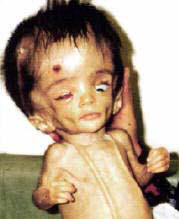
A man named Assadullah told the team in February 2003 that his wife had given birth to child so
badly deformed he hardly resembled an infant. "When I saw my little boy with those monstrous red
tumors, I thought to myself, why is it difficult for Americans to understand that they are hated in our
country?” Assadullah said. “If I do this to the child of an American family, that family has the right to
pull my eyes out of my eye sockets. I like to tell the Americans that they love to live their lives of
luxury at the expense of our extermination." [European Parliament Verbatim Report of Proceedings Apr
9/02]
Zar Ghoon is the father of another victim of U.S. bombing attacks on Kunduz. In December 2002 he
told the medical survey team, "My wife was pregnant and we were happily waiting for the moment to
see our second child. When the baby was born, it was hardly a human… When my wife saw the
baby she went into shock and died after five hours "
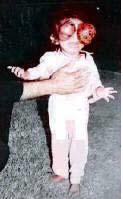
Speaking with a field volunteers near Tora Bora in April 2003, Sa'yed Gharib lost it. Screaming in
grief and rage he shouted, "What else do the Americans want? They killed us, they turned our
newborns into horrific deformations, and they turned our farmlands into graveyards and destroyed
our homes. On top of all that their planes fly over and spray us with bullets.”
"Tell America, we are not fools. Your words and actions are those of evil. We do not have airplanes
like you do, however, we have one thing that you do not have: principles and morals. We will never
do anything remotely similar to American children what Americans have done to our children and
families," declared Nurullah Omar-Khail. [Afghan DU & Recovery Fund]
According to Mohammed Daud Miraki's extensive public health survey, “Most of the people that
developed various health problems have died; others suffer from conditions such as kidney
disease/failure, confusion, and loss of immunity and painful joints.”
Dr. Durakovic told reporters, "If UMRC's Nangarhar findings are corroborated in other communities
across Afghanistan, the country faces a severe public health disaster... every subsequent generation
is at risk." [BBC May3/03]
By October 2002, Afghan doctors citing rapid deaths from internal ailments were accusing the
coalition of using chemical and radioactive weapons. The symptoms they reported (hemorrhaging,
pulmonary constriction and vomiting) could have resulted from radiation contamination. [LeMonde
Diplomatique Mar/02]
But inhalation, ingestion or wound-contamination by Depleted Uranium particles does not lead to
such acute radiation poisoning symptoms immediately after exposure. Nor would “surface water, rice
fields and catch-basins adjacent to and surrounding the bombsites have high values of uranium, up
to 27 Xs normal,” as the UMRC found.
Hank believes that Afghanistan's water table contains much more radioacative contamination than
can be ascribed to DU and NDU contamination. The effective genetic sterilization of that country's
southern region can also be traced to fallout washing down from the mountains where four American
nuclear weapons were detonated. “Rain runs downhill,” he says.
ROUTINE USE OF NUCLEAR WEAPONS?
If not exactly “routine”, Hank says, the undisclosed use of five nuclear weapons against Iraq and
Afghanistan has resulted in a dangerous shift in U.S. war fighting. As he put it, “Using tactical nukes
is now an acceptable doctrine until otherwise notified.”
Iran and the rest of the world, beware. In calling America a “Nuclear Rogue,” the New York Times
warned, “Nuclear weapons are not just another part of the military arsenal. They are different, and
lowering the threshold for their use is reckless folly.” [New York Times Mar 11/02]
As Alok O'Brien concludes, “There is no longer time to pretend that everything will be alright, and that
all thinking and feeling people need to unite in their hopes and dreams and reclaim the earth and
their birthright before it is too late.”
With th td ti i I d t i t i t W hi t ' f l
With the countdown continuing on Iran - and any constraints against Washington's use of nuclear
weapons already removed by the detonation of five low-yield nuclear bombs in Iraq and Afghanistan
- the time to act is now.
Photo Captions/Credits
Part 1
1. B2 drops B61-11 nuclear bomb casing wired.com
2. Daisy Cutter nd.edu
Part 2
1. B61-11 nuclear bomb telegraph.co.uk
2. Bush Sr. todaysgolfer.co.uk
3. MOAB mushroom cloud usatoday.com
4. Basra survivors flee American bombing ccmep.org
5. Baghdad hit by huge bombs abc.net.au
6. al-Rasheed military facility hit in southeast Baghdad AFP
7. B52D bomber defensetech.org
8. Basra before it was blown up fromthewilderness.com
Part 3
1. Tora Bora blast resembles tactical nuclear detonation cooperativeresearch.org
2. Tora Bora blast (insert) Dec 15/01 photo by Kevin Frayer AP/CP
3. Bagram Airport blast Oct 30/01 september11news.com
4. Geroge Bush must give nuclear strike orders watch.windsofchange.net
5. radiation victim (Iraq) Mar 25/04 mindfully.org
6. radiation victim (Iraq) Mar 25/04 mindfully.org